Tuesday, October 25, 2011
Bye Bye Plywood~
Alright, I *was* going to do some work on the floors upstairs in the "L" Room, but instead I ended up cutting all that scrap 1/4" plywood that's been in the stairwell and garage for months now (some over a year). It took a good hour, but it's finally all GONE. It's bundled and awaiting tomorrow morning's garbage pick-up.
Monday, October 24, 2011
Office Light Switch - DONE
I'm so happy I finished another little project.
My friend Larry commented about the knob and tube, so here's a better photo.
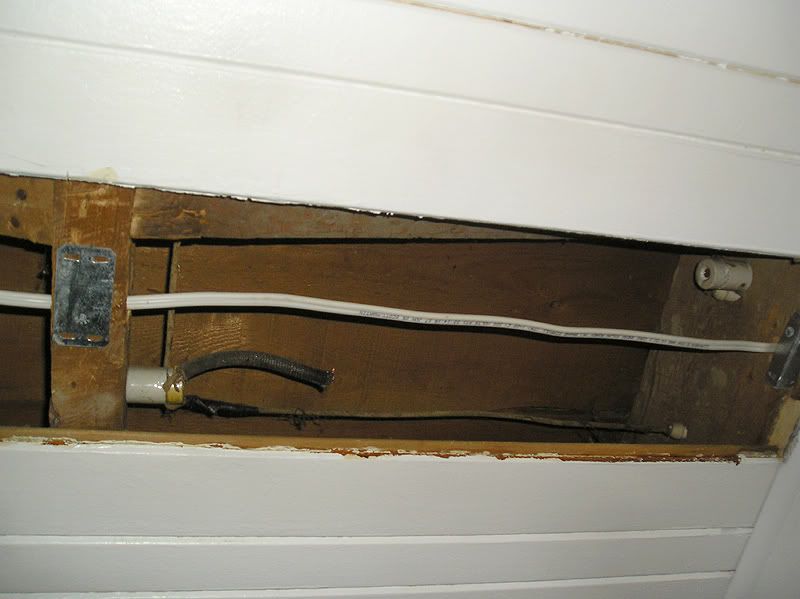
Mud coat number 2:

Scratch coat number 3:
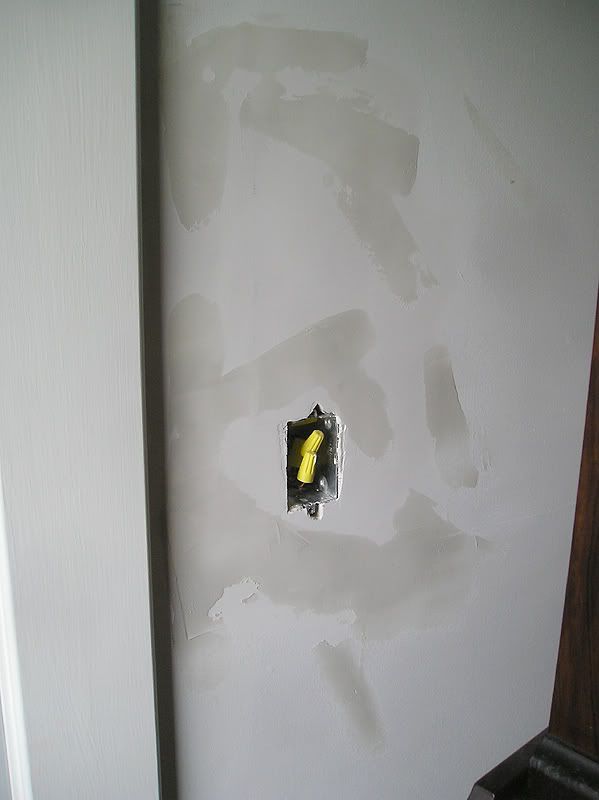
Then a quick coat of primer, and a quick coat of crappy white semi gloss (stuff I can't use since I got "Medium Base" instead of "White", so it's all milky and crappy), and voila!
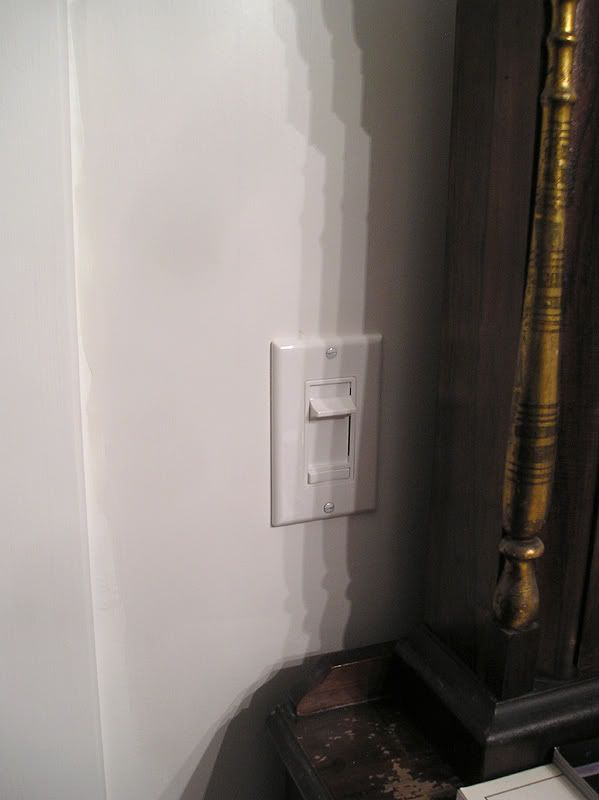
Overall not a huge amount of work, and it took only 3 days of on/off sanding, puttying, and quick painting. The white paint is just to protect the wall until I actually finish this room (later on) and paint it (probably a taupe or some other Earthy relaxing colour).
My friend Larry commented about the knob and tube, so here's a better photo.

Mud coat number 2:

Scratch coat number 3:

Then a quick coat of primer, and a quick coat of crappy white semi gloss (stuff I can't use since I got "Medium Base" instead of "White", so it's all milky and crappy), and voila!

Overall not a huge amount of work, and it took only 3 days of on/off sanding, puttying, and quick painting. The white paint is just to protect the wall until I actually finish this room (later on) and paint it (probably a taupe or some other Earthy relaxing colour).
Labels:
Drywall,
Electrical,
Light Switch,
Office,
Painting,
Patching
Saturday, October 22, 2011
Yard Sales
This is the dimmer I'll be installing. I have an identical one already in the living room. Gotta love yard sales!
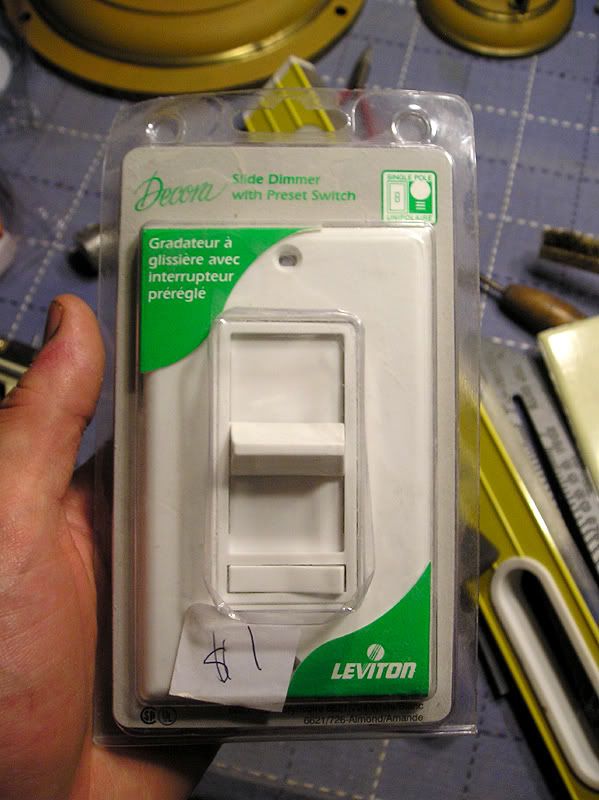
I've probably had these dimmers for over 5 years, but I KNEW how pricey they are, and I KNEW I'd eventually be using them.

I've probably had these dimmers for over 5 years, but I KNEW how pricey they are, and I KNEW I'd eventually be using them.
Office Light Fixture, Ceiling, & Electrical
I actually got stuff done this afternoon! More than I had expected, too.
First, I finished rewiring the lovely old light fixture from Mrs.D, then I tested it, took it back down, and redid both the ceiling electrical/box, and the light switch.
This was the fixture's interior "before" shot, with the original old wiring (still in usable shape, but for safety/peace of mind I don't usually reuse the old wire, since it tends to break/fray at all the joints). On one of the first fixtures I rewired, I had thought that these "hockey tape looking connections" were a poor attempt at a rewiring job, but this is how all the original wiring was done. I unwrapped on of these, and inside, all the wires are tightly wrapped/twisted together, and soldered before being wrapped in the old fashioned electrical tape. Also note that half the wires were differentiated with small knots in the wire (I didn't check weather these were the hot or neutral wires).

I also found out that this fixture is also another one that is the same sort of copper colour that was popular at the time. The shade holder I'm holding is one of the "new old stock" ones that I bought on eBay and the paint on it is still fresh/clean, like the centre part of the pan for the top of the fixture (on the right). This same colour is used on the one in the living room, both ones for the bedroom, and on this one. The only different paint finish I have is the dark green/gold one in the dining room. The other oddballs are just tarnished brass.
Also note that this fixture has 3 colours. The main body is copper (paint), with brass (unpainted) sections, and then there are also a few highlights in a dark brown (paint). Also note how dirty and dusty some of the painted parts were. Some did not clean up too well, so I had to add a clear paste wax over them and buff them a little.

Here's the fixture fully rewired. I decided to sign it. I also used light brown spray paint on the exposed sections of wire for this fixture, since the gold rayon was too flashy for this one.
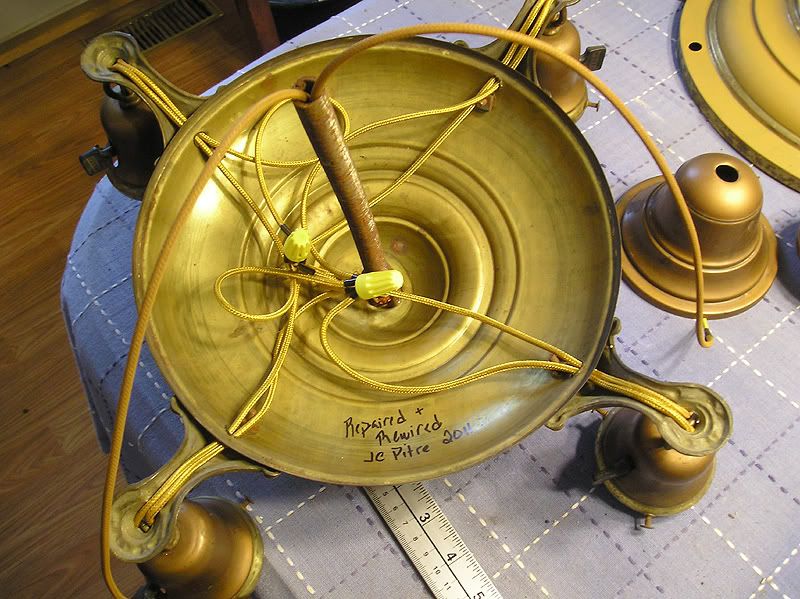
Temporarily hung from a hook for testing.
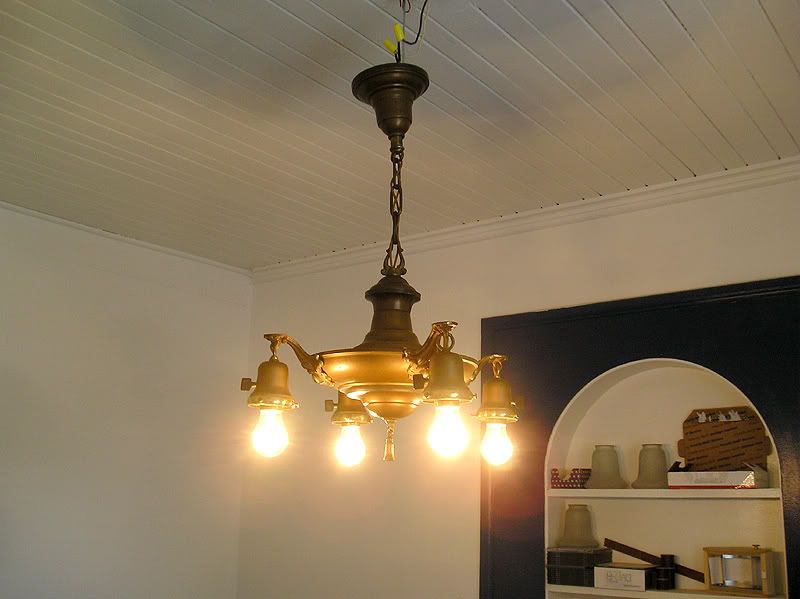
I wasn't sure weather or not I had some before photos of the crappy attempt at the ceiling patch they did when they redid the electrical, so I took some photos before yanking it down.
They just used any convenient scrap wood and SCREWED it into the joists. Then they slathered it with putty and painted it. Both the Office and Living Room were done like this.
ALSO, While taking down some of the boards, I found proof that the wall that makes up the hallway was added later. I found the original light fixture location, which would have been in line more or less with the centre of the window. I already knew the wall wasn't likely original, just because of the way that it was built around part of the window casings and the kitchen door, but now I know for sure.
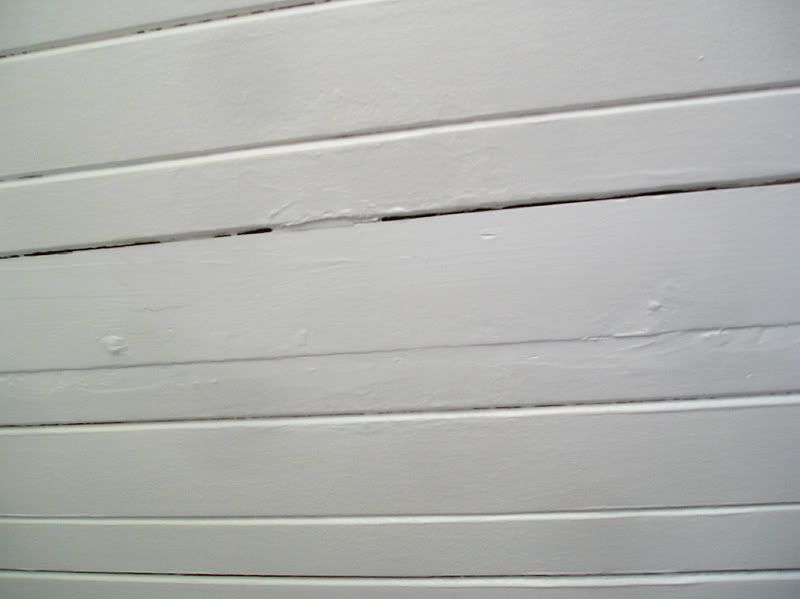
It looked especially bad around the fixture area.
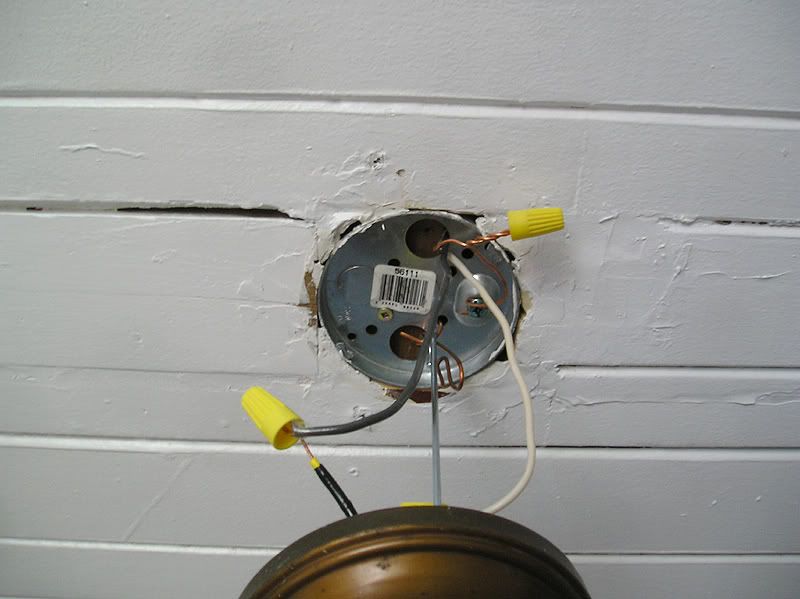
I'll come back to the ceiling later. I decided that if I was going to have to shut the power off (remember that this room is being used as my temporary bedroom and computer room), that I was also going to redo/fix the switch. Since this is a 4 bulb chandelier, I won't often want to have it cranked up, so I want to have a dimmer on it.
I started taking off the plate, but then grabbed a photo (which is why the plate screws are missing in the pic).
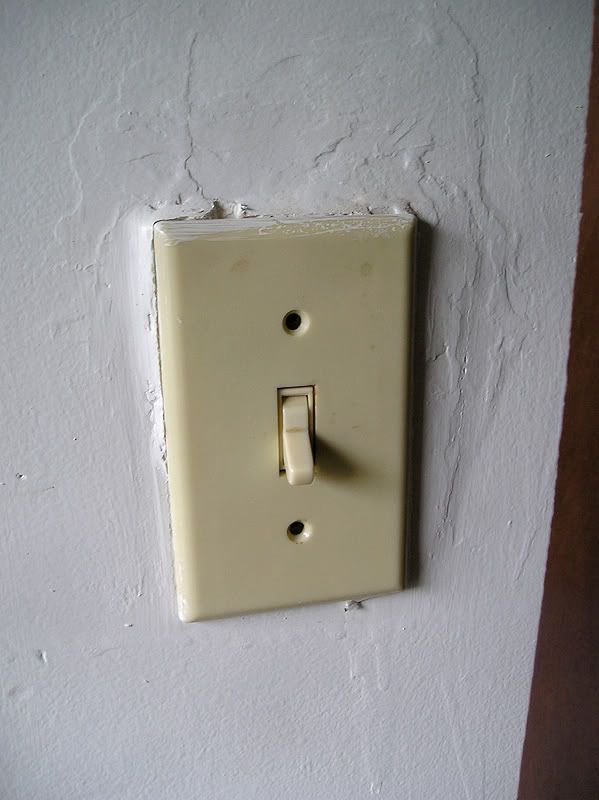
The photo doesn't really do it justice, but the blobs of filler/putty/mud are sticking out from the wall about 1/4". this would NOT do. Turns out that the stud in the wall has a major bow/twist in it, and they couldn't manage to install the box properly, even WITH a shim in there. Also, for whatever stupid reason, this light switch was WAY too high on the wall. Nearly 60" off the floor to the centre.
Now, this is an old house, so because of the fire wall bracing inside the walls, they put some of the switches rather high on the walls, which is ok with me, but 60" is insanely high for nothing. The highest one after this is about 53", 52" etc, and standard is 48" to the centre. The nearest two switches are at 48" (hallway) and 52" (next to front door for the porch light), so I went with 52".
At first, I was just going to see if I could shift the box and just sand the drywall, but if you look near the red lines on this pic, you'll see where the joint cracked. ALL of this was just patched with tons of mud. It must have taken FOREVER to dry. Some pieces were about golf ball sized.

Once removed, this was how big the hole was.
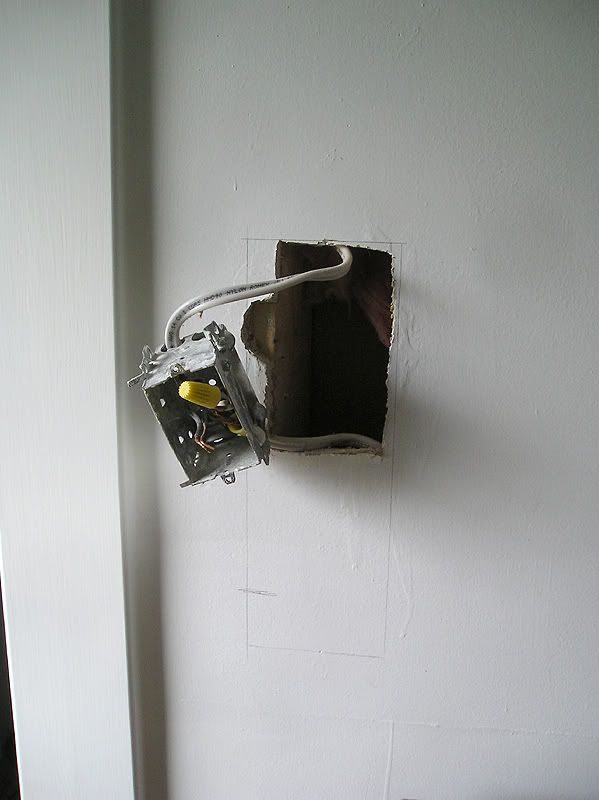
I can't tell you enough times how much I LOVE my multi-tool. It gets used in nearly ever single home DIY project I do. Here, it was used to cut drywall, and to cut the old t-g ceiling boards.
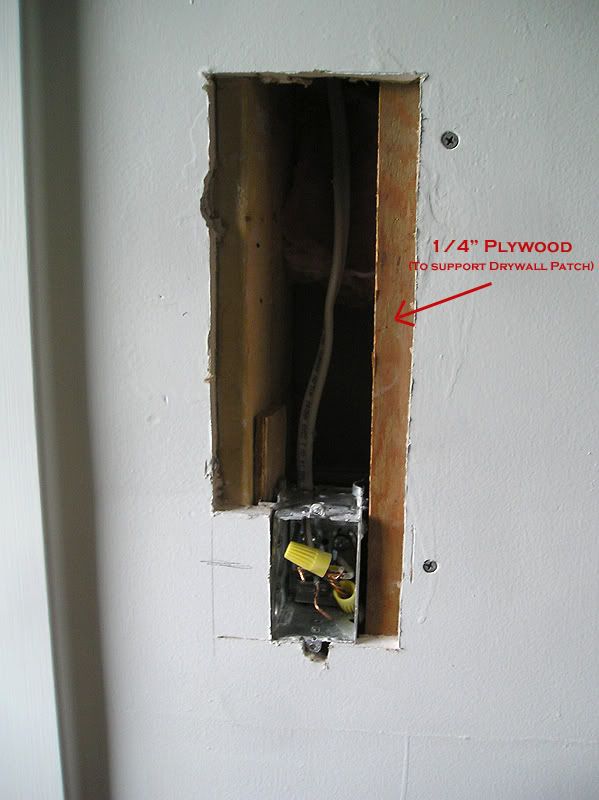
I cut the hole to lower the switch and squared it up. I also added a thin piece of scrap plywood to anchor the drywall on the interior edge. The screws on the right are sunk back because this scrap piece of drywall was an "edge piece" with the taper for mudding the joint.

Yes it looks like utter crap now, and I'm not the best mudder, but the first coat is always the cruddiest looking, and I'll likely need to do one more, possibly two, but it will look great, I promise.

So back to the ceiling. I yanked out the main crappy board, which was this funny looking piece of wood (I couldn't even guess the species unless it was some kind of diseased plank of cedar or something, since it was all a bunch of small oval spots on the interior). Then, since they had butchered the edges of the two adjoining t-g board so badly, I also had to yank those. So 2 narrow boards, and one wide, and in the living room it was one wide and one narrow. Since all the ceiling work is done, now I have no excuse to delay replacing the t-g boards, so I might work on them next week (either at home or at work).
In between the floors is a ton of old dust and cobwebs, so this was a dirty and dusty job. This was some of the aftermath:
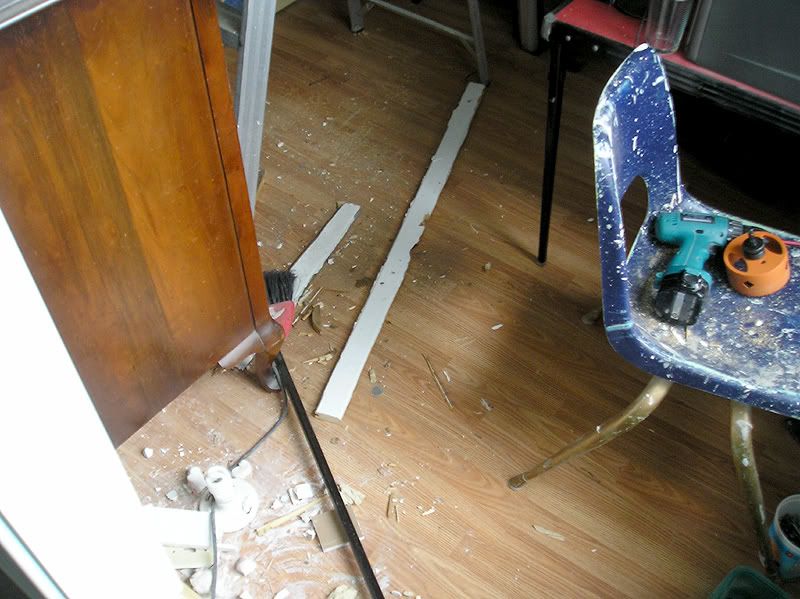
And here is the chandelier all installed and ready to use (still have no switch for it yet, or shades). It looks AWESOME. I had to go out and buy a "special" bracket to mount it to the ceiling box. It's just a standard looking strap, but it has the larger half inch threaded hole with coarse threads.
While I was out, I also bought 10 sheets of drywall, and 2 sheets of plywood. And DAMMIT, I ***JUST*** remembered that I forgot to order the 2x3s I needed. This was to continue work on the upstairs closets/walls in the "L" Room/Guest Room. They're only delivering it next Saturday, so I can always go back and add that to the delivery.
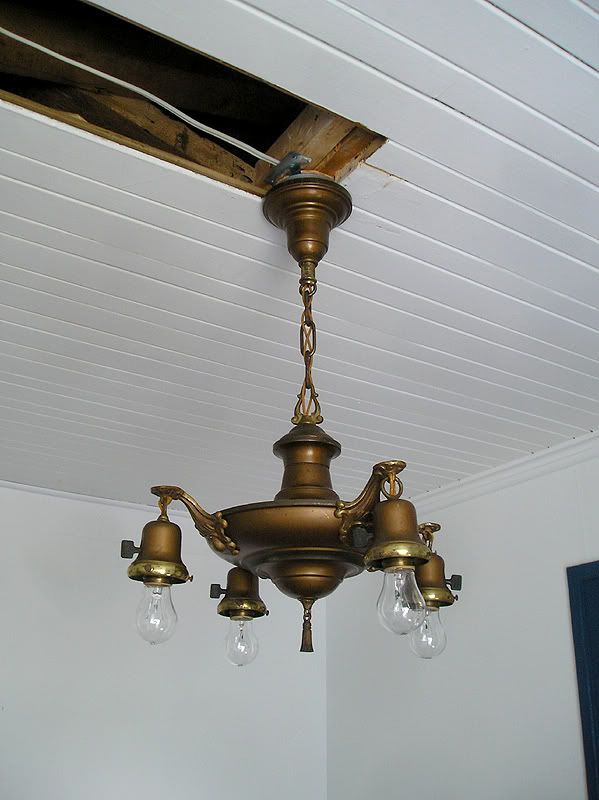
With the ceiling boards popped out, I now have a hole that looks into the upstairs bedroom, though this board: http://i1018.photobucket.com/albums/af308/clockmaker15/HOUSE/P1010717.jpg
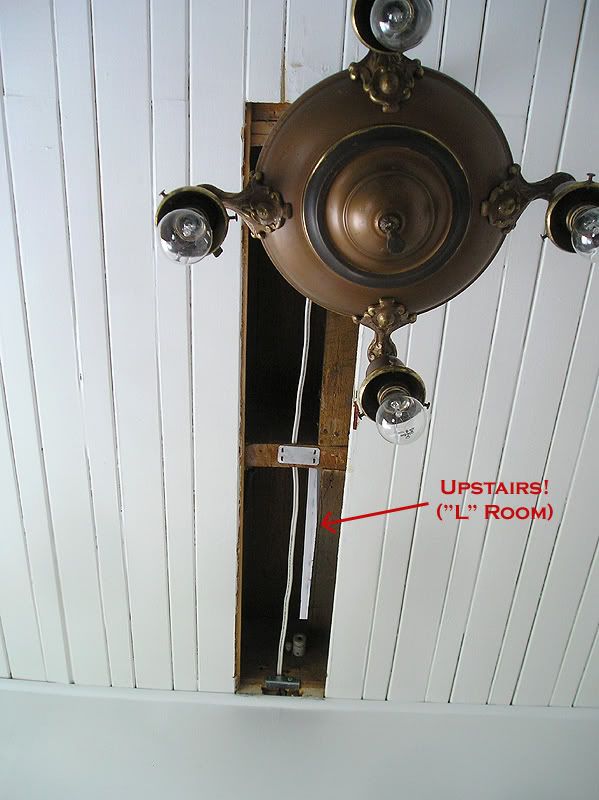
Looking down a bit, you can see the tops of two of my clocks (this was after cleaning everything), and the completely redone door casings for the doorway.
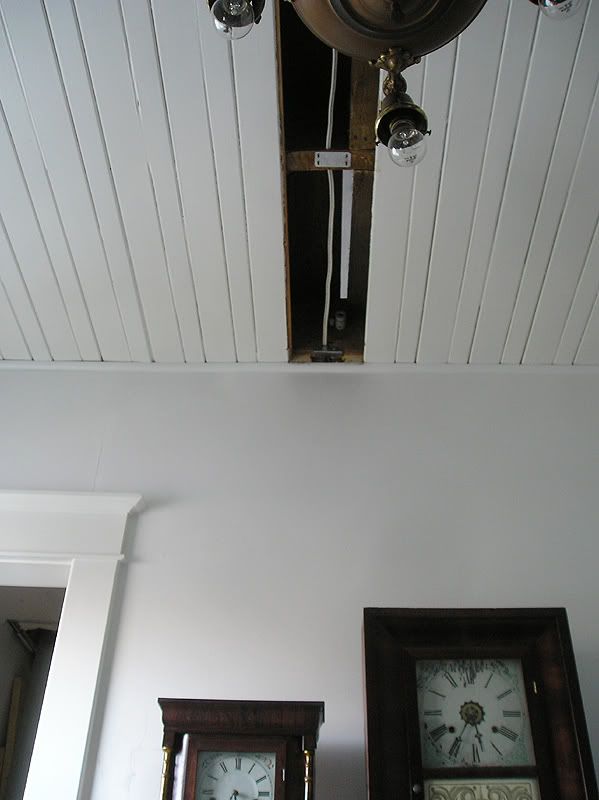
And since I know people will want to see the whole clocks (the above photo was meant to catch part of the fixture in the same photo), here:
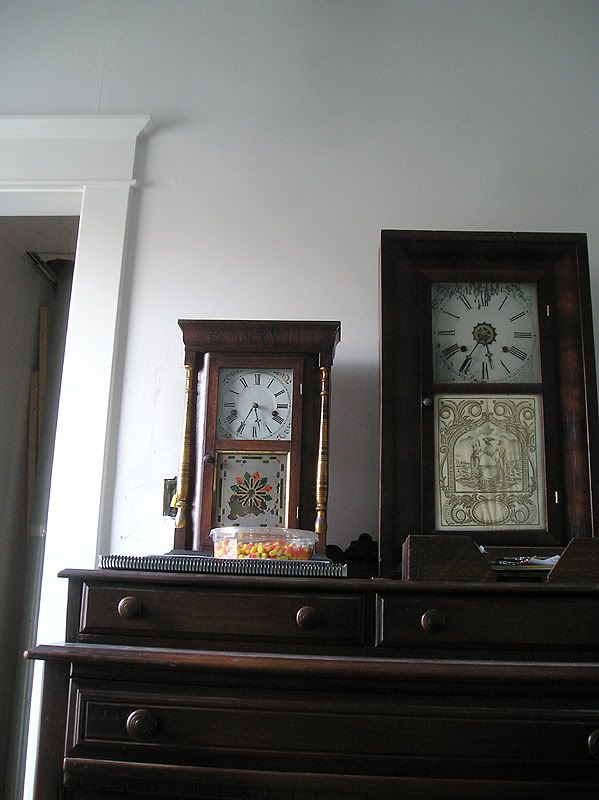
The one on the left is a nearly mint condition 100% original Ansonia clock from around 1860, and next to it is a refinished and repaired (and much more pedestrian) Waterbury Ogee clock from around 1870, which has a temporary decal in the door (in a clear bag, which is why it looks wrinkled), which I haven't adhered to the glass yet. It's a gold transfer that will get adhered to the door, and painted (reverse painted) in a few colours. It's been like this for a few years... The ogee was my first antique clock purchase off eBay, and after a whole bunch of different repairs, it's an extremely reliable timekeeper, and I use the built-in alarm to wake up in the mornings for work. It's VERY LOUD.
The antique dresser is part of my bedroom set, from around the 1920s. It's solid walnut and I adore it. Someday I'll fix all the nicks and scratches on it with shellac. There was a time when I had thought about refinishing them, but now I'd NEVER do this. The finish is original, and since it's shellac, it can easily be touched up. The side of the dresser and one of it's cabriole legs can be seen in the "Aftermath" photo above.
Also, CANDY CORN! :D
First, I finished rewiring the lovely old light fixture from Mrs.D, then I tested it, took it back down, and redid both the ceiling electrical/box, and the light switch.
This was the fixture's interior "before" shot, with the original old wiring (still in usable shape, but for safety/peace of mind I don't usually reuse the old wire, since it tends to break/fray at all the joints). On one of the first fixtures I rewired, I had thought that these "hockey tape looking connections" were a poor attempt at a rewiring job, but this is how all the original wiring was done. I unwrapped on of these, and inside, all the wires are tightly wrapped/twisted together, and soldered before being wrapped in the old fashioned electrical tape. Also note that half the wires were differentiated with small knots in the wire (I didn't check weather these were the hot or neutral wires).

I also found out that this fixture is also another one that is the same sort of copper colour that was popular at the time. The shade holder I'm holding is one of the "new old stock" ones that I bought on eBay and the paint on it is still fresh/clean, like the centre part of the pan for the top of the fixture (on the right). This same colour is used on the one in the living room, both ones for the bedroom, and on this one. The only different paint finish I have is the dark green/gold one in the dining room. The other oddballs are just tarnished brass.
Also note that this fixture has 3 colours. The main body is copper (paint), with brass (unpainted) sections, and then there are also a few highlights in a dark brown (paint). Also note how dirty and dusty some of the painted parts were. Some did not clean up too well, so I had to add a clear paste wax over them and buff them a little.

Here's the fixture fully rewired. I decided to sign it. I also used light brown spray paint on the exposed sections of wire for this fixture, since the gold rayon was too flashy for this one.

Temporarily hung from a hook for testing.

I wasn't sure weather or not I had some before photos of the crappy attempt at the ceiling patch they did when they redid the electrical, so I took some photos before yanking it down.
They just used any convenient scrap wood and SCREWED it into the joists. Then they slathered it with putty and painted it. Both the Office and Living Room were done like this.
ALSO, While taking down some of the boards, I found proof that the wall that makes up the hallway was added later. I found the original light fixture location, which would have been in line more or less with the centre of the window. I already knew the wall wasn't likely original, just because of the way that it was built around part of the window casings and the kitchen door, but now I know for sure.

It looked especially bad around the fixture area.

I'll come back to the ceiling later. I decided that if I was going to have to shut the power off (remember that this room is being used as my temporary bedroom and computer room), that I was also going to redo/fix the switch. Since this is a 4 bulb chandelier, I won't often want to have it cranked up, so I want to have a dimmer on it.
I started taking off the plate, but then grabbed a photo (which is why the plate screws are missing in the pic).

The photo doesn't really do it justice, but the blobs of filler/putty/mud are sticking out from the wall about 1/4". this would NOT do. Turns out that the stud in the wall has a major bow/twist in it, and they couldn't manage to install the box properly, even WITH a shim in there. Also, for whatever stupid reason, this light switch was WAY too high on the wall. Nearly 60" off the floor to the centre.
Now, this is an old house, so because of the fire wall bracing inside the walls, they put some of the switches rather high on the walls, which is ok with me, but 60" is insanely high for nothing. The highest one after this is about 53", 52" etc, and standard is 48" to the centre. The nearest two switches are at 48" (hallway) and 52" (next to front door for the porch light), so I went with 52".
At first, I was just going to see if I could shift the box and just sand the drywall, but if you look near the red lines on this pic, you'll see where the joint cracked. ALL of this was just patched with tons of mud. It must have taken FOREVER to dry. Some pieces were about golf ball sized.

Once removed, this was how big the hole was.

I can't tell you enough times how much I LOVE my multi-tool. It gets used in nearly ever single home DIY project I do. Here, it was used to cut drywall, and to cut the old t-g ceiling boards.

I cut the hole to lower the switch and squared it up. I also added a thin piece of scrap plywood to anchor the drywall on the interior edge. The screws on the right are sunk back because this scrap piece of drywall was an "edge piece" with the taper for mudding the joint.

Yes it looks like utter crap now, and I'm not the best mudder, but the first coat is always the cruddiest looking, and I'll likely need to do one more, possibly two, but it will look great, I promise.

So back to the ceiling. I yanked out the main crappy board, which was this funny looking piece of wood (I couldn't even guess the species unless it was some kind of diseased plank of cedar or something, since it was all a bunch of small oval spots on the interior). Then, since they had butchered the edges of the two adjoining t-g board so badly, I also had to yank those. So 2 narrow boards, and one wide, and in the living room it was one wide and one narrow. Since all the ceiling work is done, now I have no excuse to delay replacing the t-g boards, so I might work on them next week (either at home or at work).
In between the floors is a ton of old dust and cobwebs, so this was a dirty and dusty job. This was some of the aftermath:

And here is the chandelier all installed and ready to use (still have no switch for it yet, or shades). It looks AWESOME. I had to go out and buy a "special" bracket to mount it to the ceiling box. It's just a standard looking strap, but it has the larger half inch threaded hole with coarse threads.
While I was out, I also bought 10 sheets of drywall, and 2 sheets of plywood. And DAMMIT, I ***JUST*** remembered that I forgot to order the 2x3s I needed. This was to continue work on the upstairs closets/walls in the "L" Room/Guest Room. They're only delivering it next Saturday, so I can always go back and add that to the delivery.

With the ceiling boards popped out, I now have a hole that looks into the upstairs bedroom, though this board: http://i1018.photobucket.com/albums/af308/clockmaker15/HOUSE/P1010717.jpg

Looking down a bit, you can see the tops of two of my clocks (this was after cleaning everything), and the completely redone door casings for the doorway.

And since I know people will want to see the whole clocks (the above photo was meant to catch part of the fixture in the same photo), here:

The one on the left is a nearly mint condition 100% original Ansonia clock from around 1860, and next to it is a refinished and repaired (and much more pedestrian) Waterbury Ogee clock from around 1870, which has a temporary decal in the door (in a clear bag, which is why it looks wrinkled), which I haven't adhered to the glass yet. It's a gold transfer that will get adhered to the door, and painted (reverse painted) in a few colours. It's been like this for a few years... The ogee was my first antique clock purchase off eBay, and after a whole bunch of different repairs, it's an extremely reliable timekeeper, and I use the built-in alarm to wake up in the mornings for work. It's VERY LOUD.
The antique dresser is part of my bedroom set, from around the 1920s. It's solid walnut and I adore it. Someday I'll fix all the nicks and scratches on it with shellac. There was a time when I had thought about refinishing them, but now I'd NEVER do this. The finish is original, and since it's shellac, it can easily be touched up. The side of the dresser and one of it's cabriole legs can be seen in the "Aftermath" photo above.
Also, CANDY CORN! :D
Wednesday, October 19, 2011
Major October Update (Part II)
Alright, so as I was saying last night, I started working on the "L" room* upstairs. The plan is pretty simple: Rebuild the closets (which were too tiny to be useful), redo the floors, redo the ceiling (new drywall), and general stuff like clean-up the mouldings, patch the walls, paint, etc.
* Note: I only call it the "L" room because it's L shaped.
I had started to tear down the closet walls ages ago, but I did a lot more work recently by opening-up the hallway wall. The reason for this is to add a built-in linen closet. The house has very little storage space other than the basement, so I wanted a spot near the bathroom to store bath towels, bedsheets, toiletries and other items.
Here's the spot where the built-in will go. I originally wanted to make it almost up to the ceiling, but I took a look at all sorts of gathered photos of old 1920's built-ins, and none except for very rare exceptions were taller than an average door, so I plan to make this one the same. This means that all 3 openings will be done in one set of continuous casings(mouldings), with the doors to the spare/guest room, and the "L" room on each side.
This is viewed from the bathroom door (the doorway to the right is the main staircase).
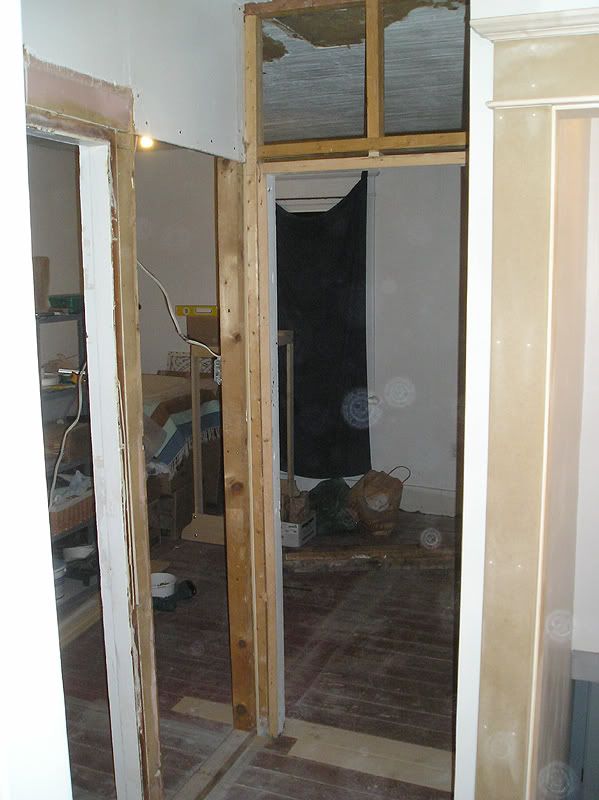
Doorway to the "L" room:
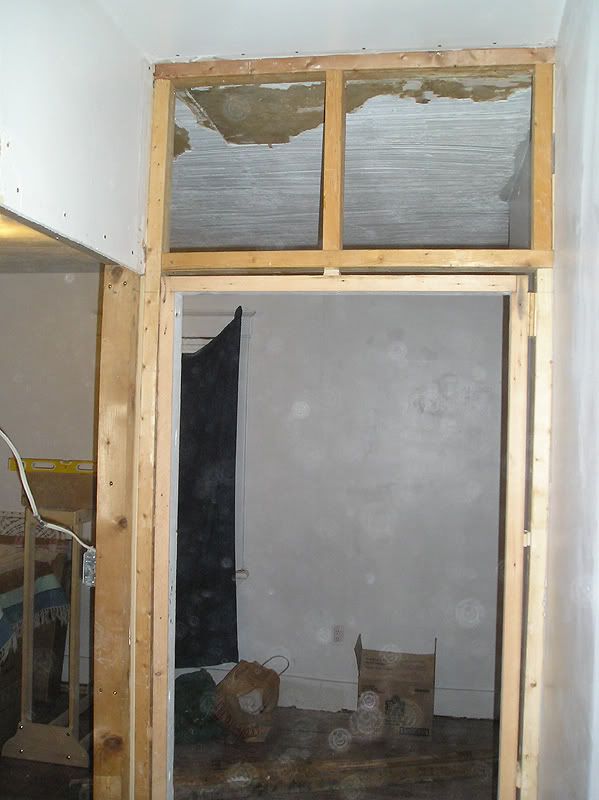
From the "L" room looking towards the bathroom:

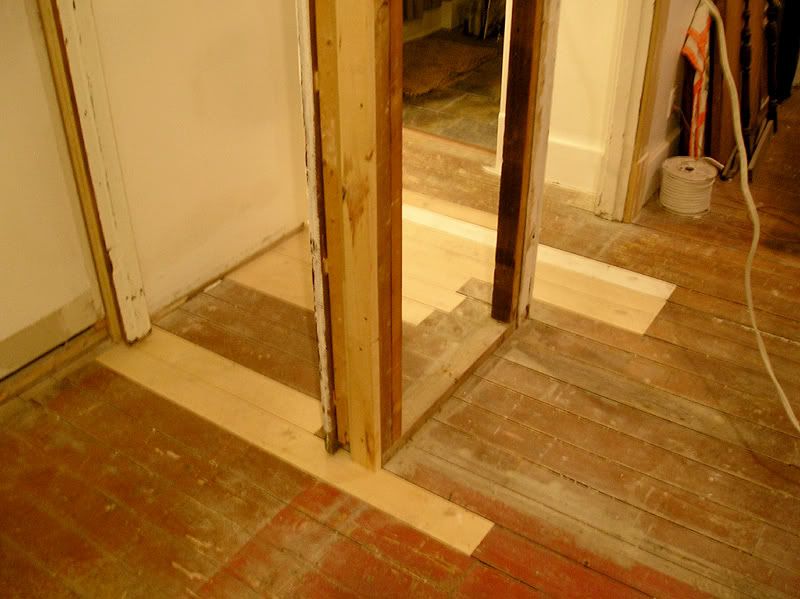
From guest room (aka Laundry room):
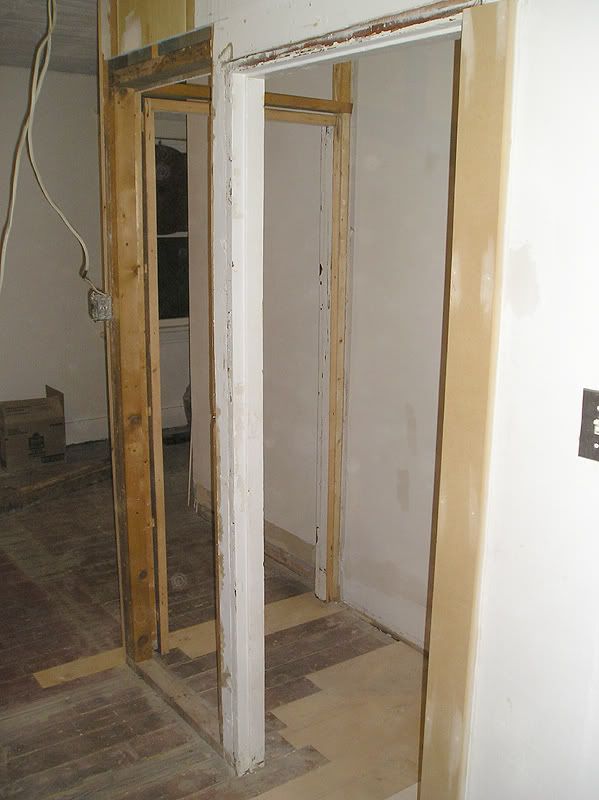
The ceiling in the "L" room will be a fun job. I plan to drywall over this, but some of the plaster/mud that they added is caked-on super thick in places. If it's still fairly easy to scrape off, I might take it all down, otherwise I'll keep going until I'm at a relatively thin spot.
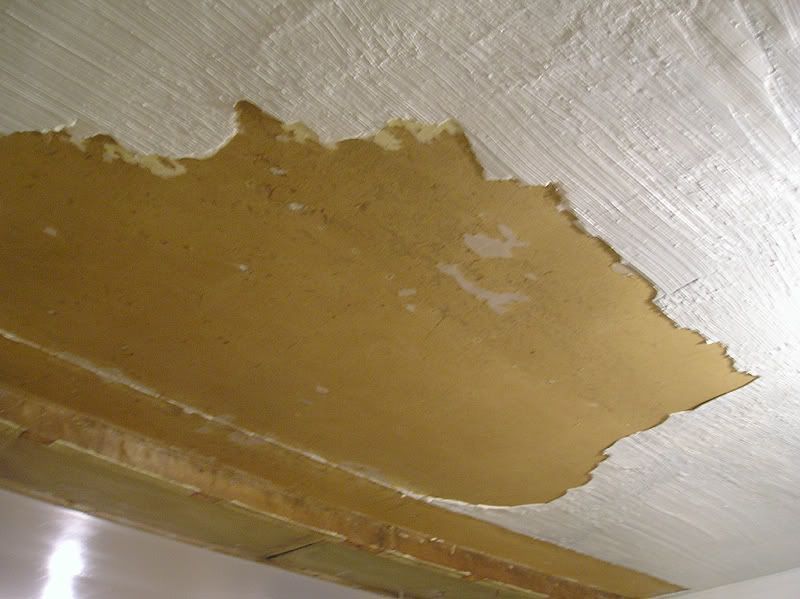
I also started to patch the floor. These are spots left to fix.
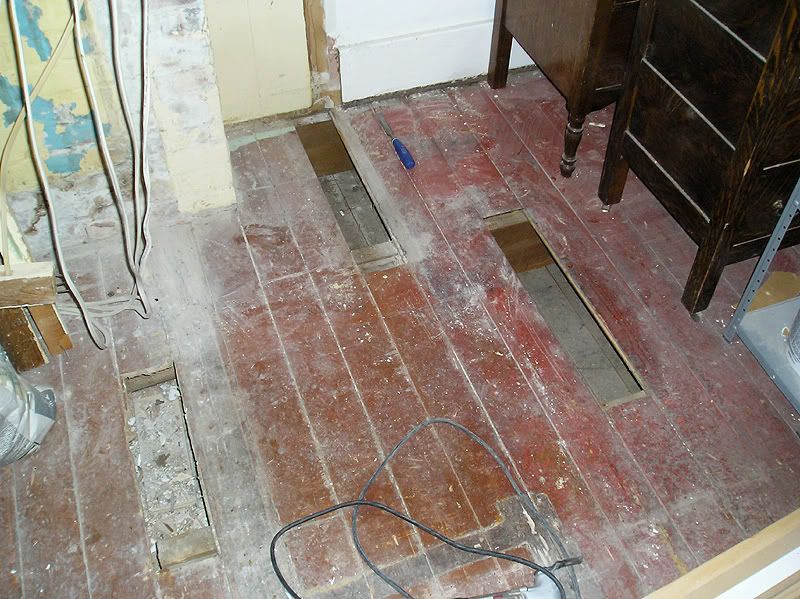
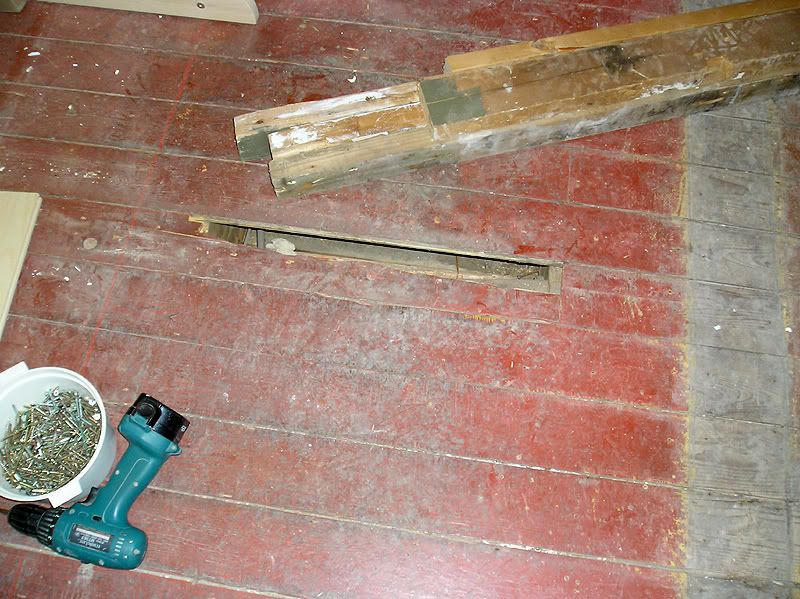
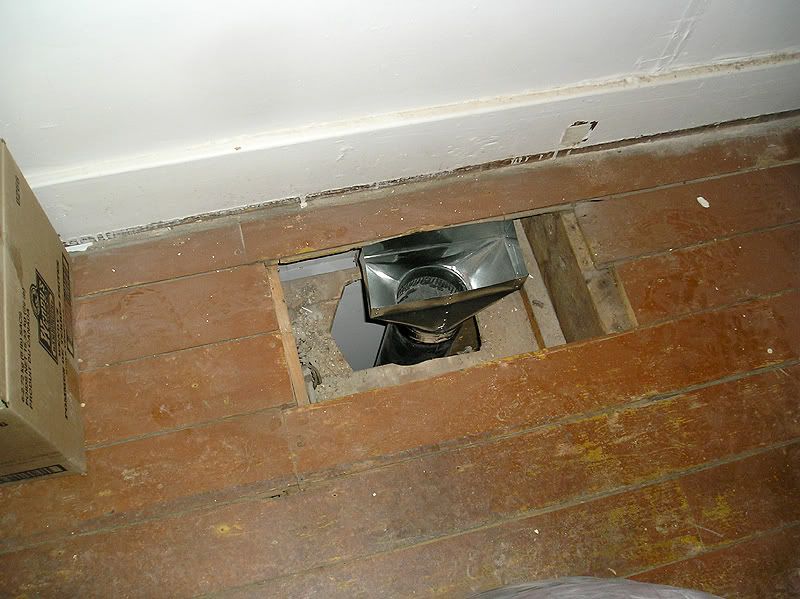
Lastly is the porch window. I removed the porch window in spring or early summer so that I could replace the missing muntin in the bottom (see main blog photo for the before).
I don't think I posted about the muntin repair here, so here's a very quick recap.
Match the profile (as close as possible) on some clear pine. In my case, I was able to do it entirely on the table saw (close enough profile that no one will notice a difference).

Carefully cut and notch your pieces to fit (measure carefully, and aim for a snug fit).
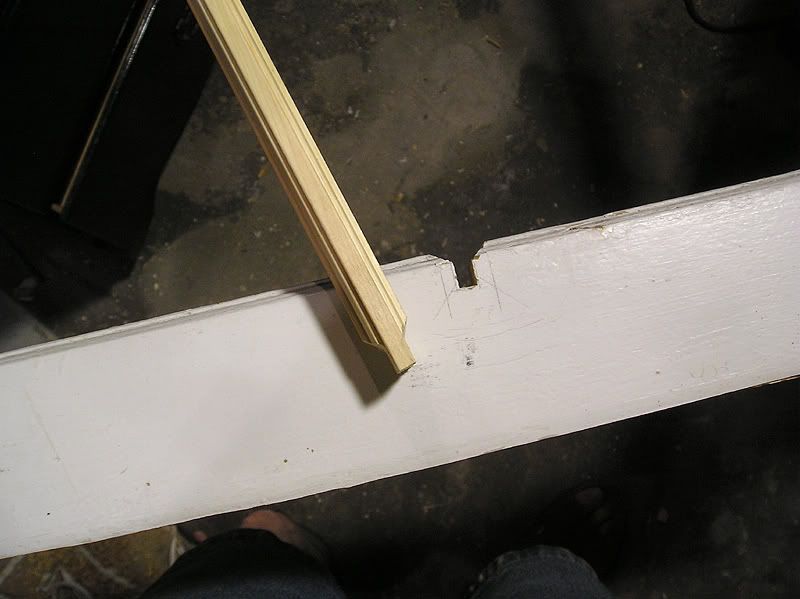
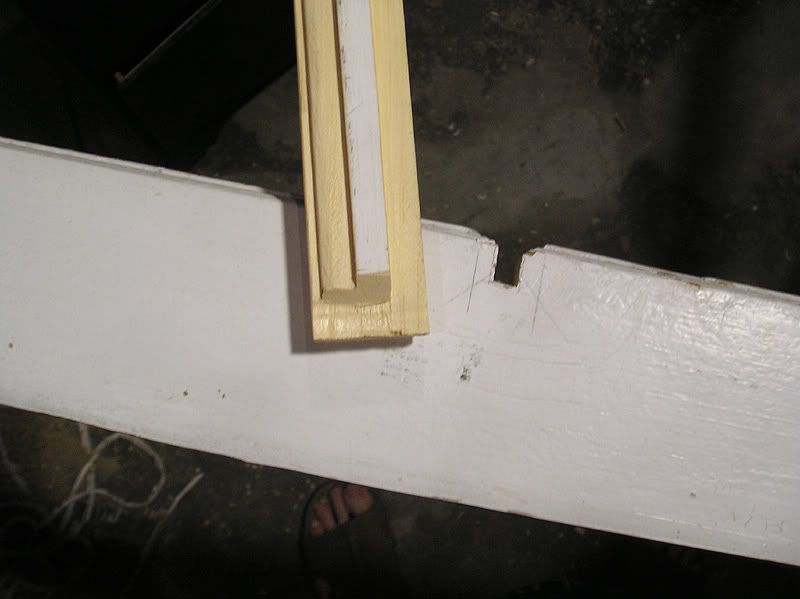
Glue, clamp, putty, sand, prime.
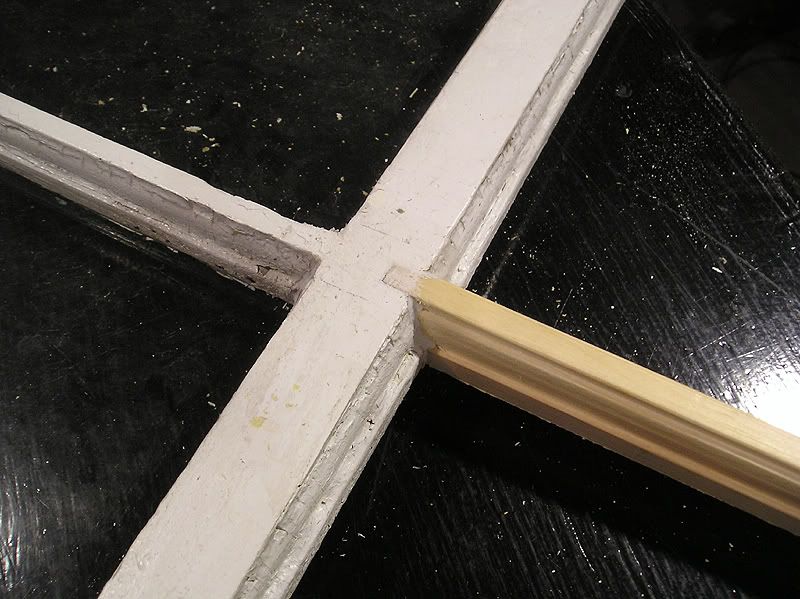

So yeah, fast forward to Monday night, when I finally decided to install the glass and do the glazing. I did the top 2 1/2 panes on Mon night, and the large bottom 2 last night. For an idea of size, the window is 3 feet wide by 5 feet high.
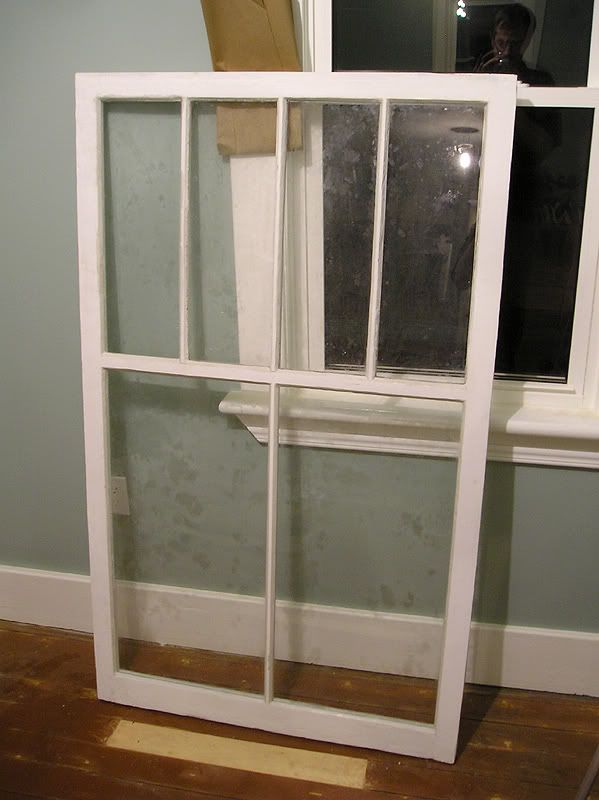
The glazing job isn't perfect, but the entire window is in rough shape, with many edges gouged, chipped, puttied, filled and re-filled, etc. But the new centre muntin one looks great!
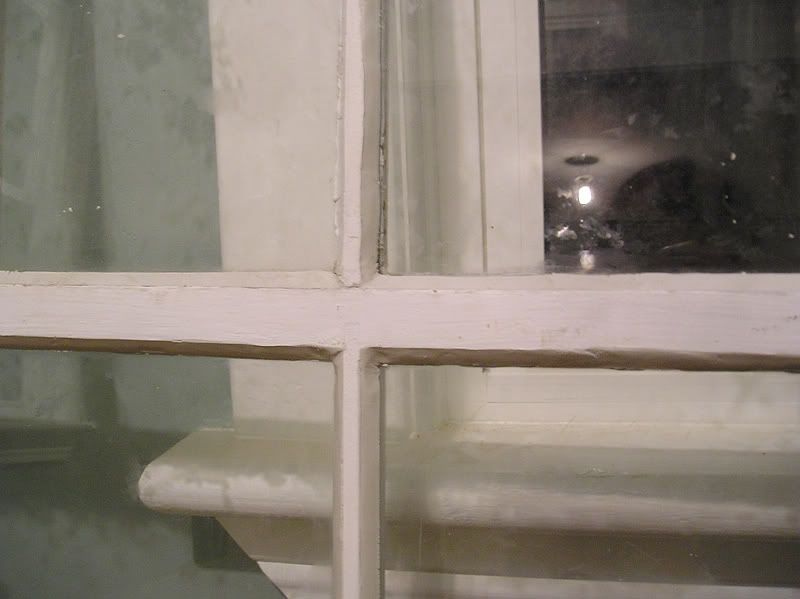
This is what the porch has looked like pretty much all summer/fall. Notice all the dead leaves starting to drift in by the opening.
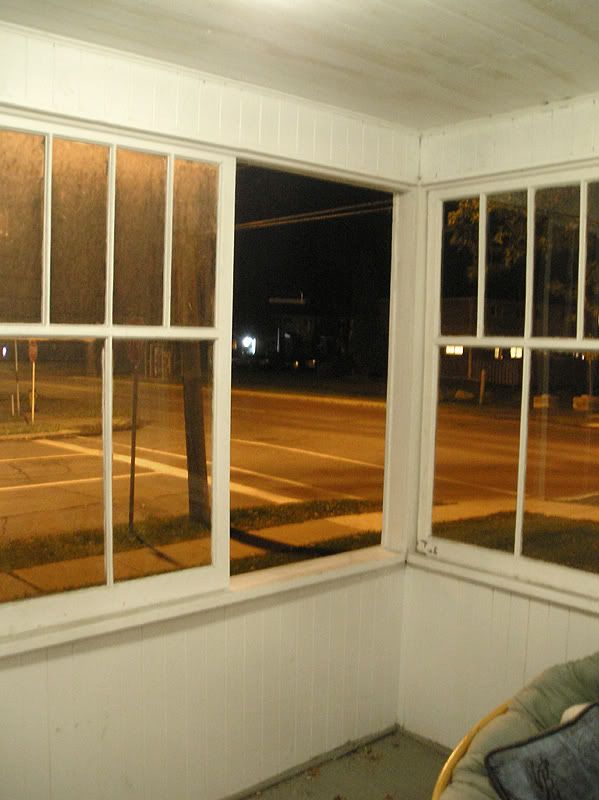
I have the window in the MB (since there's lots of room to work), so I'm hoping that the crappy Dap33 will dry in a week or so. I'd like to paint and install the window before winter.
* Note: I only call it the "L" room because it's L shaped.
I had started to tear down the closet walls ages ago, but I did a lot more work recently by opening-up the hallway wall. The reason for this is to add a built-in linen closet. The house has very little storage space other than the basement, so I wanted a spot near the bathroom to store bath towels, bedsheets, toiletries and other items.
Here's the spot where the built-in will go. I originally wanted to make it almost up to the ceiling, but I took a look at all sorts of gathered photos of old 1920's built-ins, and none except for very rare exceptions were taller than an average door, so I plan to make this one the same. This means that all 3 openings will be done in one set of continuous casings(mouldings), with the doors to the spare/guest room, and the "L" room on each side.
This is viewed from the bathroom door (the doorway to the right is the main staircase).

Doorway to the "L" room:

From the "L" room looking towards the bathroom:


From guest room (aka Laundry room):

The ceiling in the "L" room will be a fun job. I plan to drywall over this, but some of the plaster/mud that they added is caked-on super thick in places. If it's still fairly easy to scrape off, I might take it all down, otherwise I'll keep going until I'm at a relatively thin spot.

I also started to patch the floor. These are spots left to fix.



Lastly is the porch window. I removed the porch window in spring or early summer so that I could replace the missing muntin in the bottom (see main blog photo for the before).
I don't think I posted about the muntin repair here, so here's a very quick recap.
Match the profile (as close as possible) on some clear pine. In my case, I was able to do it entirely on the table saw (close enough profile that no one will notice a difference).

Carefully cut and notch your pieces to fit (measure carefully, and aim for a snug fit).


Glue, clamp, putty, sand, prime.


So yeah, fast forward to Monday night, when I finally decided to install the glass and do the glazing. I did the top 2 1/2 panes on Mon night, and the large bottom 2 last night. For an idea of size, the window is 3 feet wide by 5 feet high.

The glazing job isn't perfect, but the entire window is in rough shape, with many edges gouged, chipped, puttied, filled and re-filled, etc. But the new centre muntin one looks great!

This is what the porch has looked like pretty much all summer/fall. Notice all the dead leaves starting to drift in by the opening.

I have the window in the MB (since there's lots of room to work), so I'm hoping that the crappy Dap33 will dry in a week or so. I'd like to paint and install the window before winter.
Tuesday, October 18, 2011
Major October Update
Alright, this is the kind of update your guys want to see. In this post, I'll cover the work I did on the cold air return going upstairs to the MB, work on the upstairs closet/built-in/floors, a new light fixture, and work on reglazing the porch window.
I'll start with the light fixture. This is another lovely 1910-20 fixture like the others I've bought, but this one was a gift from one of my readers, Mrs. D from 1893 Victorian Farmhouse. She is a wonderful lady who, with the help of her husband, are restoring a wonderful old Victorian. You should check out her blog. She has done a really great job so far, and she's in one of my top 10 favourite "old house" blogs. She is also an artist (currently working on building a studio), upholsterer, and handy woman.
The fixture is complete, and in nearly perfect shape (the paint isn't flaking or scratched-up), and I hope to rewire it soon-ish. When I first got it, it was fitted with 3 (of 4, 1 is missing) floral fitters to make it a "bare bulb" fixture, with these unscrew, and I'm using it with shades (which I haven't bought yet). The shades pictured below are 4 of the set of 6 that I'll be using in the Master Bedroom on the two matched fixtures (I needed 5 matching but I'll have a spare). These are to give an idea of how it will look with shades on it. I also hung it temporarily in the Office (where it will be going) to see how it would look.


I can't wait to redo that ugly blue built-in (mine will have casings to match the doors/windows in the house, and 2 glass doors).
Duct Work:
As usual in all the projects, the demolition is the most fun part. This is then immediately followed by a lot of head shaking, and eye-rolling. I think that the next few photos speak for themselves. To note is the location of the outlet. These are two really good "before" photos from when I bought the house back in April 2010.
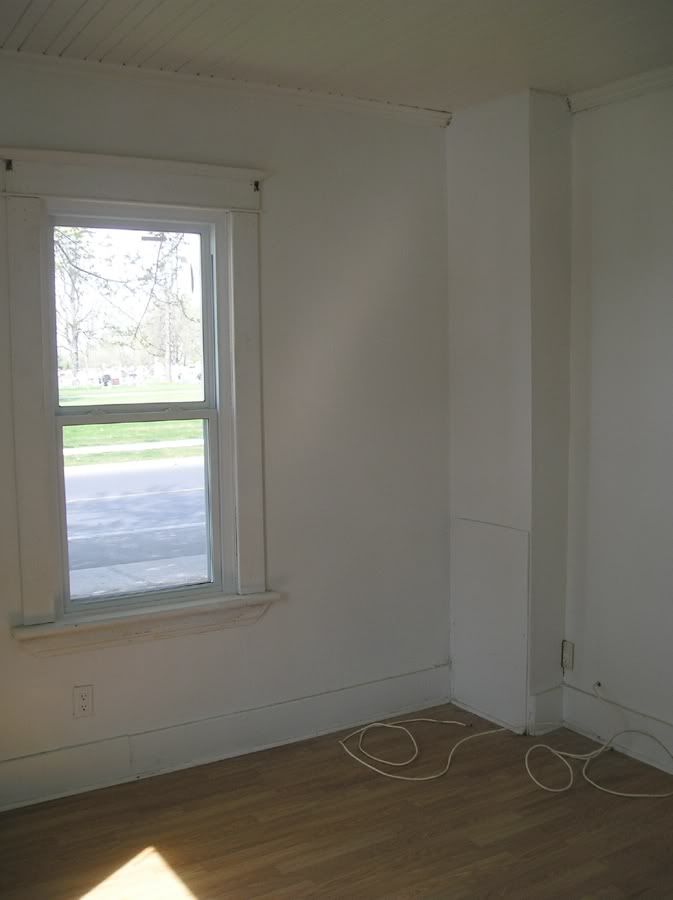
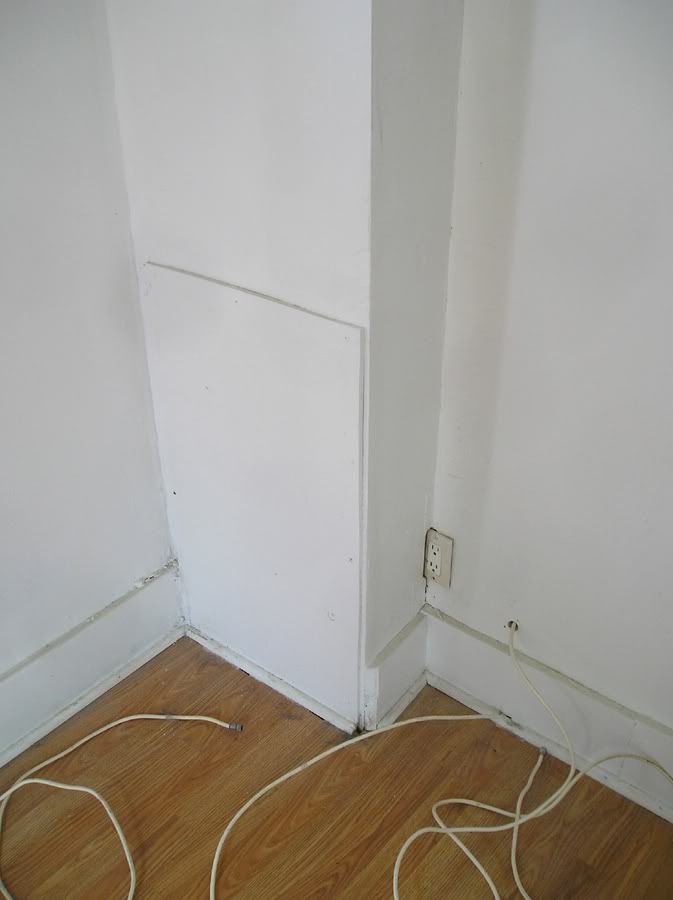
Here's the demolition... And no I didn't bother to move any clocks/plants, etc. I was pretty careful.
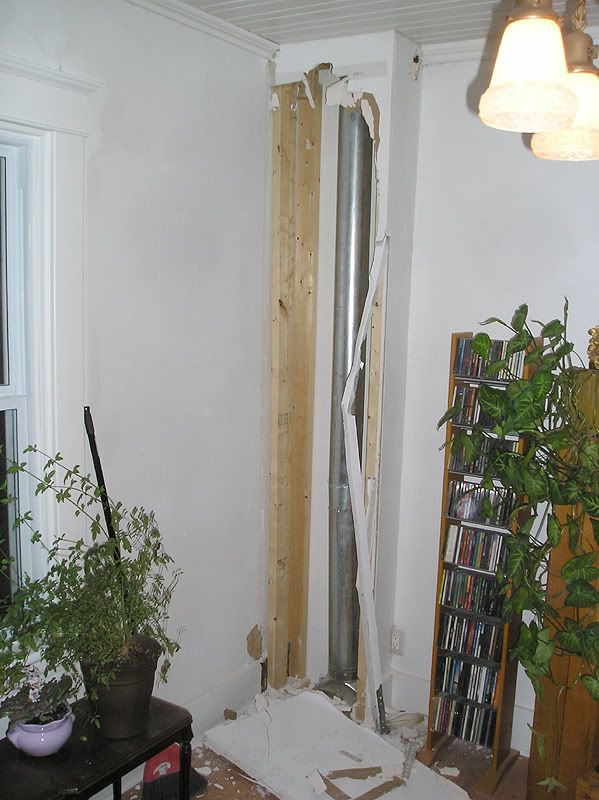
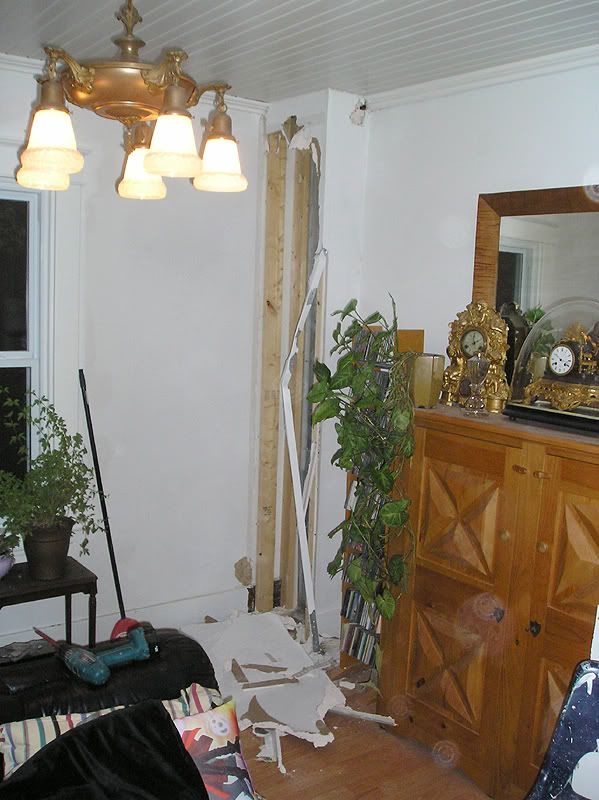
Notice all the patched-together pieces.
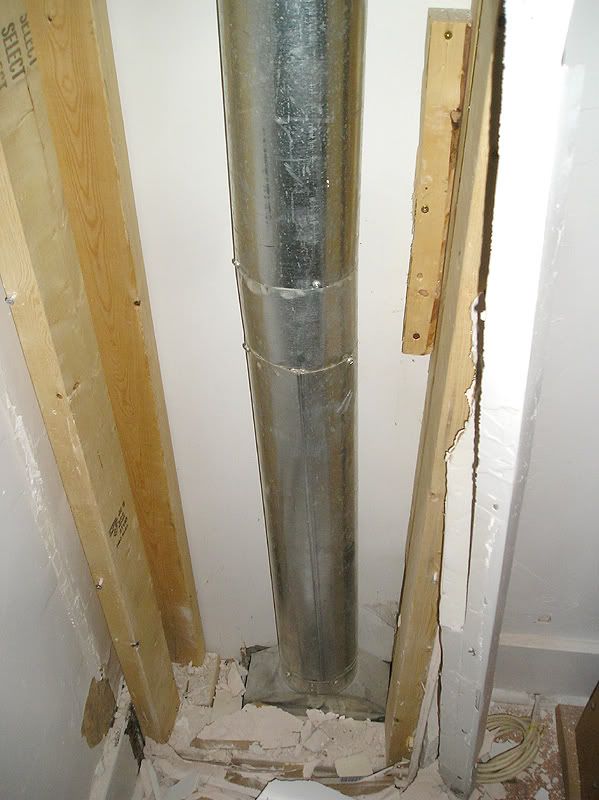
...yeah. In a way I'm really glad they did it the lazy/complicated way, since this avoided cutting the crown.
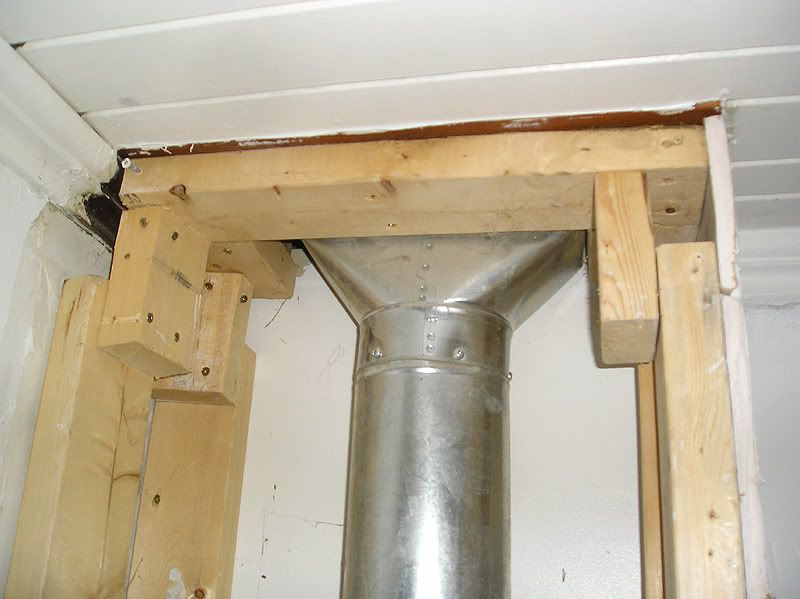
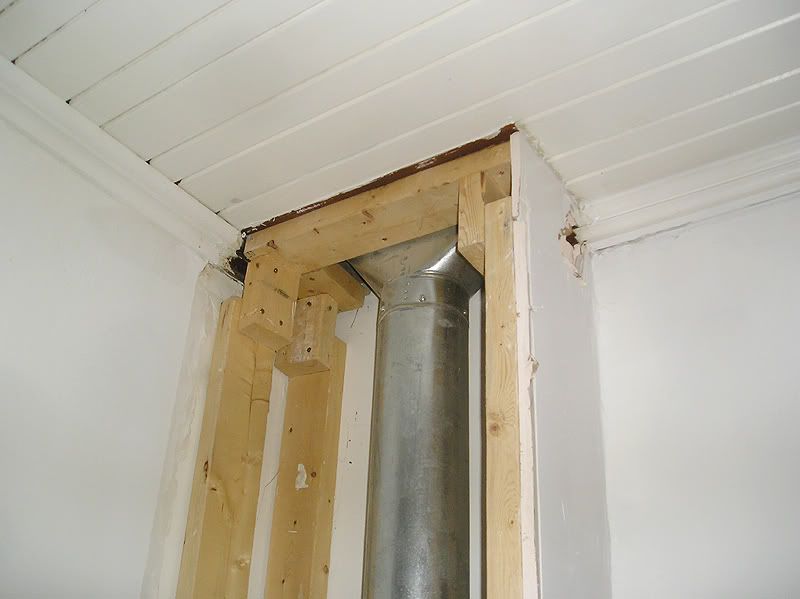
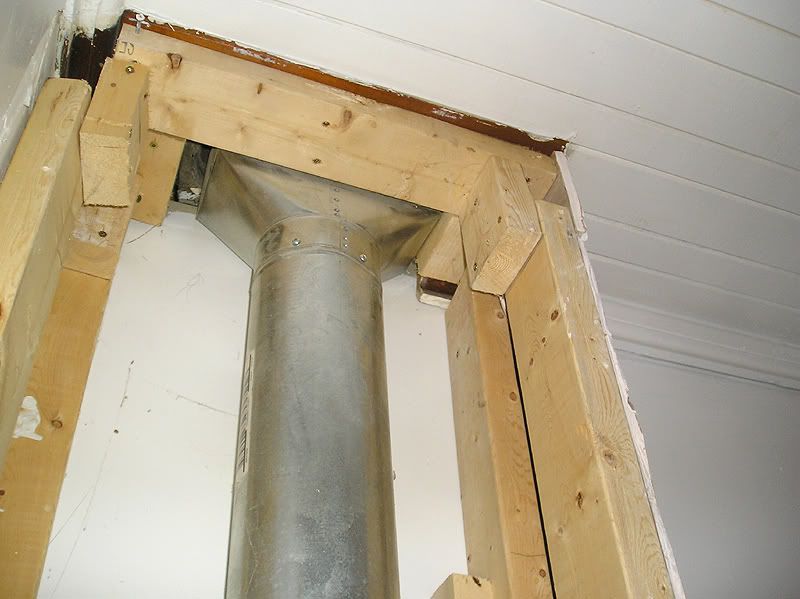

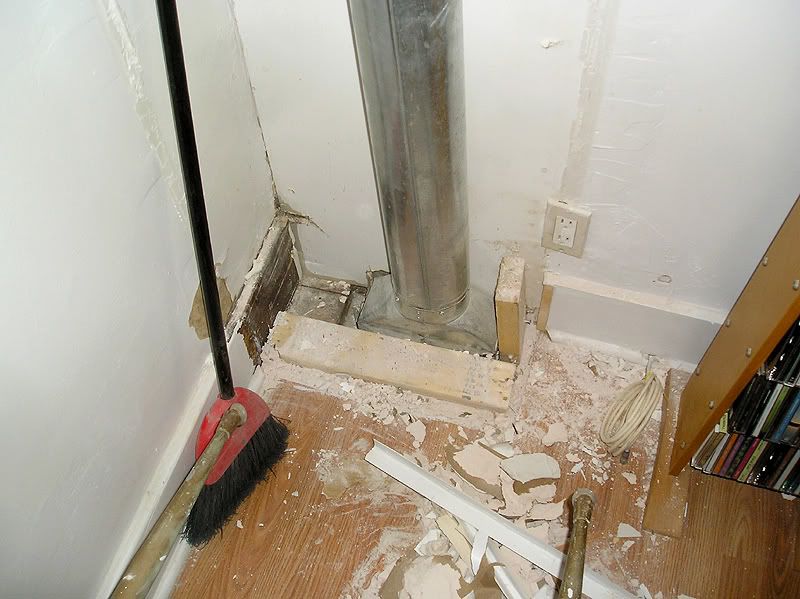
Now to fully understand the amazing-ness of this botchery, you need to realize that from the basement, it looked like this: (Apparently I've lost the photo). Basically, the connection going up from the basement was an overly long and unnecessarily coiled snake-like mess of couplings, finishing in an angled boot fitting (one of those 5x10 that connects to a 5" round pipe) which was screwed to the floor (or rather the ceiling in the basement). In the living room (the photos you see above), the connection was made with another boot at the bottom, which was NOT CONNECTED in any way. You could swing it back and forth. The top was another boot fitting that was screwed to the t-g ceiling, and not really connected to this:
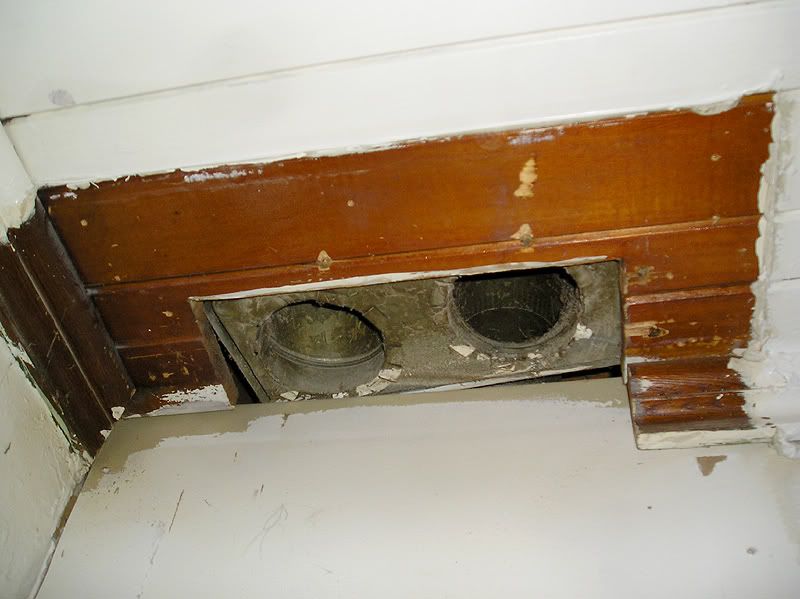
That's an old connection that divided in two directions going to both floor registers in the MB. I think these are from the 50's or 60's maybe? I'm sure they were originally hooked up with a rectangular duct.
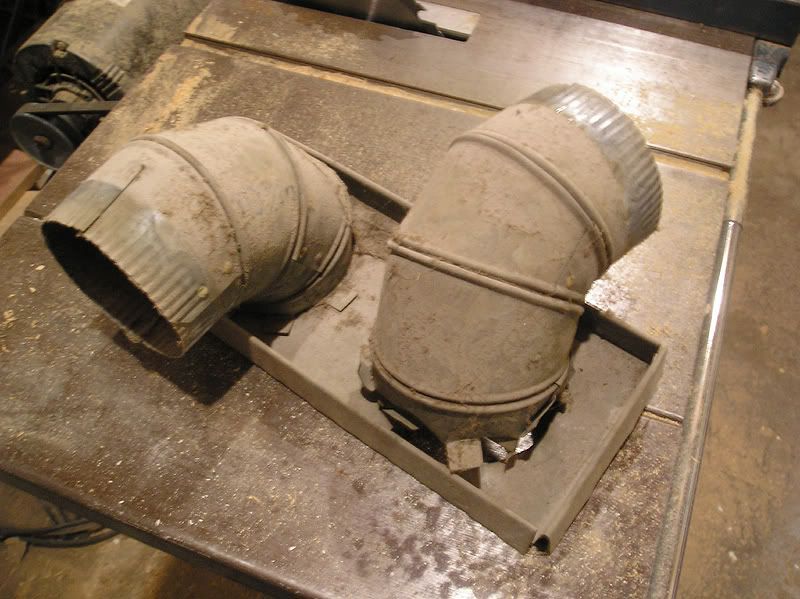
Also, as a side note, I had previously mentioned that the vent on the North side (over the dining room) had a lot of water damage to the original t-g ceiling in the dining room (which is probably one of the reasons that they covered it in drywall). You can see the damage in these comparison photos of both floor duct openings.
North (damaged) one:
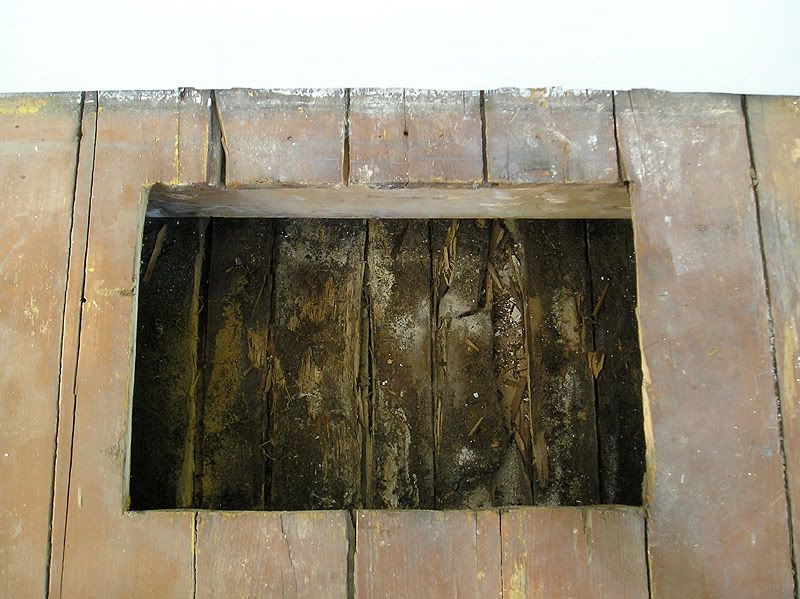
South vent:
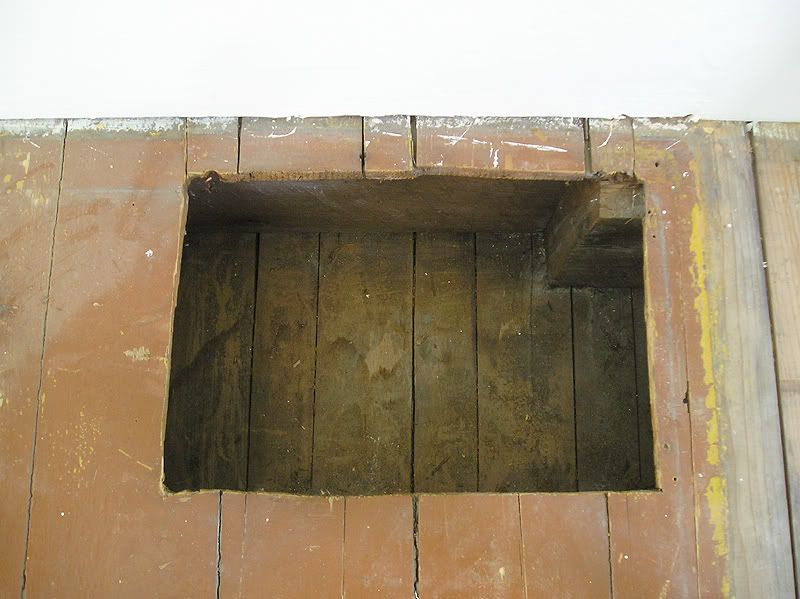
I haven't redone the South one, but it will be a challenge with that odd corner piece in there. All the rest of these are all of the North vent(cold air return).
Here's my fancy hand-made tin box. This was made from scratch, using only leftover pieces of round ducts, flattened-out, scored, cut, folded, and held together with some "pop rivets".

I had to add a 2x4 along the edge that was away from the wall, which is why there's a long row of patched nail holes. I used a screw on each end in the solid boards.
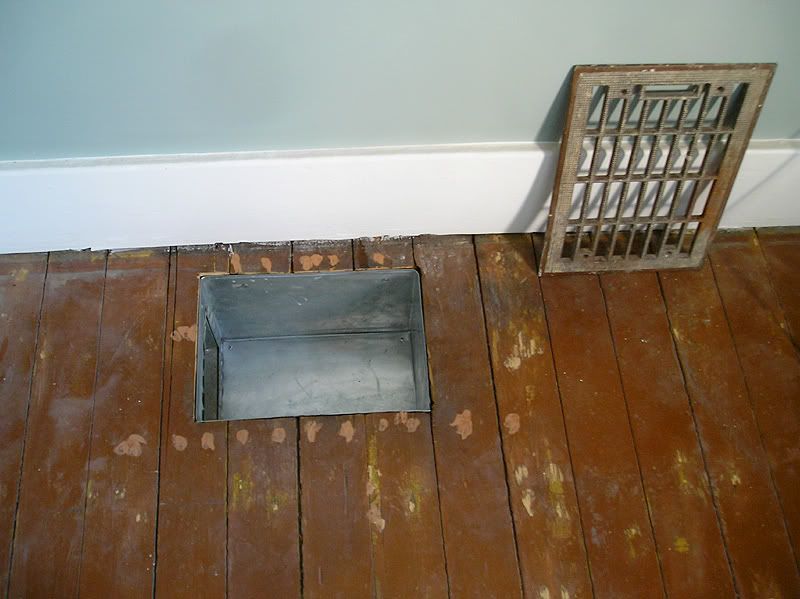

And this is with all the little chunks of broken wood trimmed and reglued, and all the holes patched and sanded.

The connections in the floor (about 5 feet long of straight duct) was done the same way that the old duct was done: in 3 sections (just long enough that I could slide them in between the floors through the 12x8" register opening. Once in the floor, they were assembled and the joints were taped. Getting all the fittings together in the final assembly was very tricky, but not too hard.
Here's the finished job.
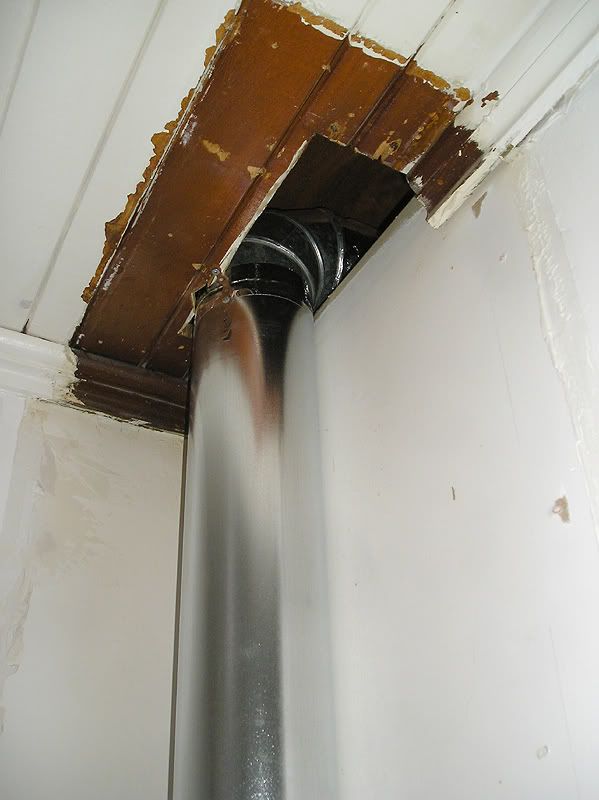
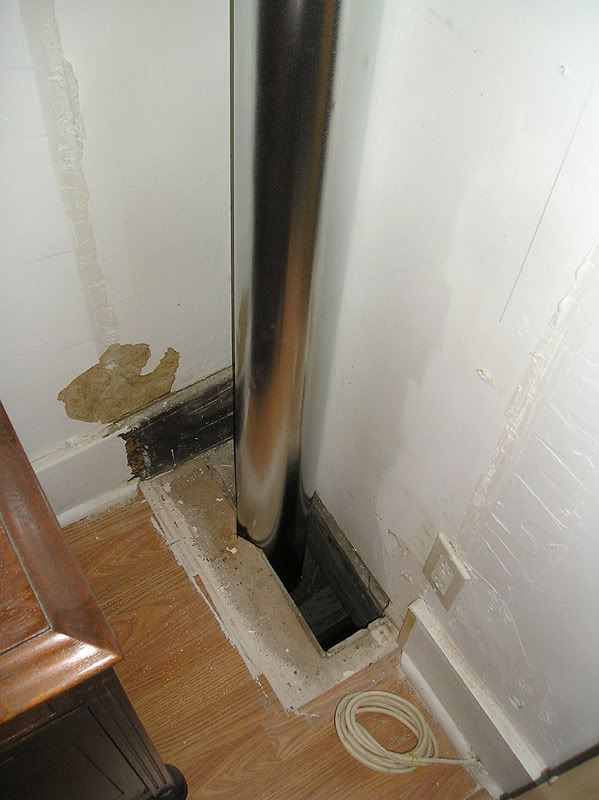
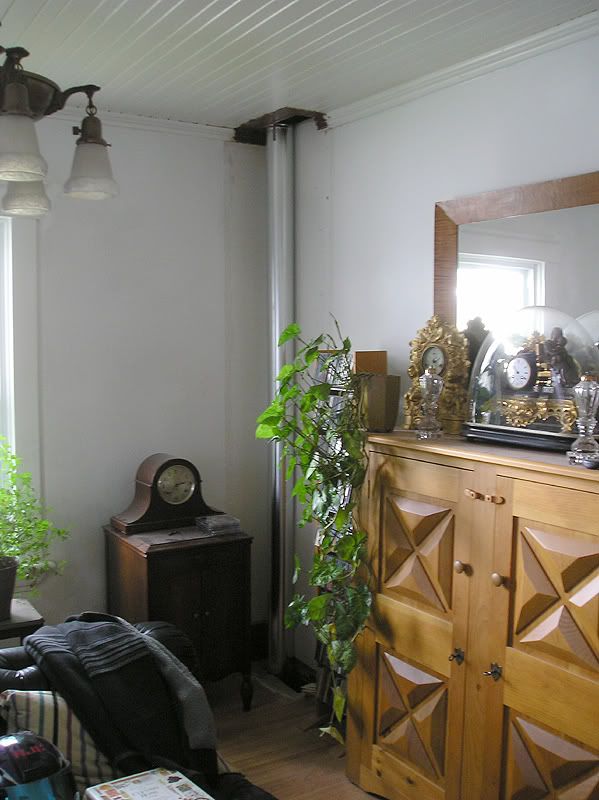
From basement: I have no idea why they didn't do it this way in the first place. There was NO REASON why they couldn't just do a straight L shape, even if they had used the stupid boot connection (which was stupid).
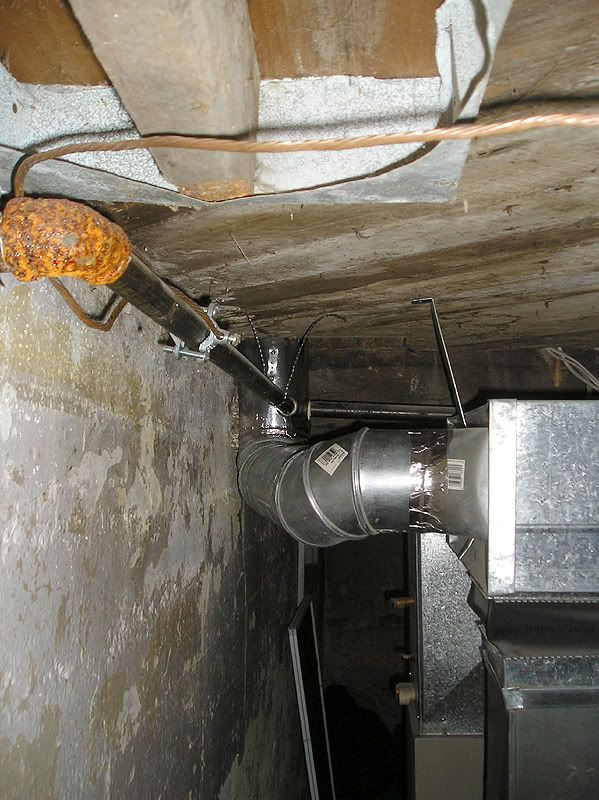
And yes I plan to buff-off the rust and repaint that iron gas pipe fitting.
It's getting late, so I'll actually cover the rest ("L" Room closet/built-in and floor, and the reglazed porch window) tomorrow.
I'll start with the light fixture. This is another lovely 1910-20 fixture like the others I've bought, but this one was a gift from one of my readers, Mrs. D from 1893 Victorian Farmhouse. She is a wonderful lady who, with the help of her husband, are restoring a wonderful old Victorian. You should check out her blog. She has done a really great job so far, and she's in one of my top 10 favourite "old house" blogs. She is also an artist (currently working on building a studio), upholsterer, and handy woman.
The fixture is complete, and in nearly perfect shape (the paint isn't flaking or scratched-up), and I hope to rewire it soon-ish. When I first got it, it was fitted with 3 (of 4, 1 is missing) floral fitters to make it a "bare bulb" fixture, with these unscrew, and I'm using it with shades (which I haven't bought yet). The shades pictured below are 4 of the set of 6 that I'll be using in the Master Bedroom on the two matched fixtures (I needed 5 matching but I'll have a spare). These are to give an idea of how it will look with shades on it. I also hung it temporarily in the Office (where it will be going) to see how it would look.


I can't wait to redo that ugly blue built-in (mine will have casings to match the doors/windows in the house, and 2 glass doors).
Duct Work:
As usual in all the projects, the demolition is the most fun part. This is then immediately followed by a lot of head shaking, and eye-rolling. I think that the next few photos speak for themselves. To note is the location of the outlet. These are two really good "before" photos from when I bought the house back in April 2010.


Here's the demolition... And no I didn't bother to move any clocks/plants, etc. I was pretty careful.


Notice all the patched-together pieces.

...yeah. In a way I'm really glad they did it the lazy/complicated way, since this avoided cutting the crown.





Now to fully understand the amazing-ness of this botchery, you need to realize that from the basement, it looked like this: (Apparently I've lost the photo). Basically, the connection going up from the basement was an overly long and unnecessarily coiled snake-like mess of couplings, finishing in an angled boot fitting (one of those 5x10 that connects to a 5" round pipe) which was screwed to the floor (or rather the ceiling in the basement). In the living room (the photos you see above), the connection was made with another boot at the bottom, which was NOT CONNECTED in any way. You could swing it back and forth. The top was another boot fitting that was screwed to the t-g ceiling, and not really connected to this:

That's an old connection that divided in two directions going to both floor registers in the MB. I think these are from the 50's or 60's maybe? I'm sure they were originally hooked up with a rectangular duct.

Also, as a side note, I had previously mentioned that the vent on the North side (over the dining room) had a lot of water damage to the original t-g ceiling in the dining room (which is probably one of the reasons that they covered it in drywall). You can see the damage in these comparison photos of both floor duct openings.
North (damaged) one:

South vent:

I haven't redone the South one, but it will be a challenge with that odd corner piece in there. All the rest of these are all of the North vent(cold air return).
Here's my fancy hand-made tin box. This was made from scratch, using only leftover pieces of round ducts, flattened-out, scored, cut, folded, and held together with some "pop rivets".

I had to add a 2x4 along the edge that was away from the wall, which is why there's a long row of patched nail holes. I used a screw on each end in the solid boards.


And this is with all the little chunks of broken wood trimmed and reglued, and all the holes patched and sanded.

The connections in the floor (about 5 feet long of straight duct) was done the same way that the old duct was done: in 3 sections (just long enough that I could slide them in between the floors through the 12x8" register opening. Once in the floor, they were assembled and the joints were taped. Getting all the fittings together in the final assembly was very tricky, but not too hard.
Here's the finished job.



From basement: I have no idea why they didn't do it this way in the first place. There was NO REASON why they couldn't just do a straight L shape, even if they had used the stupid boot connection (which was stupid).

And yes I plan to buff-off the rust and repaint that iron gas pipe fitting.
It's getting late, so I'll actually cover the rest ("L" Room closet/built-in and floor, and the reglazed porch window) tomorrow.
Subscribe to:
Posts (Atom)
